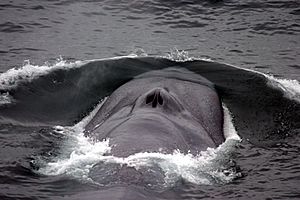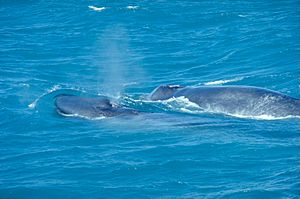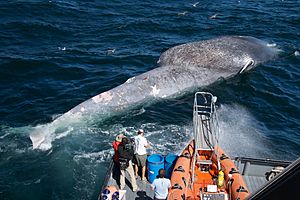Blue whale facts for kids
The blue whale (Balaenoptera musculus) is a huge marine mammal and a type of baleen whale. It's the biggest animal ever known to have lived on Earth! Blue whales can grow up to 29.9 meters (98 ft) long and weigh as much as 199 tonnes (196 long tons; 219 short tons). Their long, thin bodies are usually grayish-blue on top and a bit lighter underneath.
There are different types of blue whales, called subspecies. These include B. m. musculus in the North Atlantic and North Pacific, B. m. intermedia in the Southern Ocean, and B. m. brevicauda (also known as the pygmy blue whale) in the Indian and South Pacific Oceans. There's also B. m. indica in the Northern Indian Ocean.
Blue whales usually travel long distances. They move from their summer feeding spots near the North and South Poles to warmer areas near the equator for winter, where they have their babies. Some whales might stay in one area all year, or only certain groups might migrate.
Blue whales are filter feeders, meaning they filter their food from the water. They eat almost only tiny shrimp-like creatures called krill. Blue whales are often found alone or in small groups. They don't have a strong social structure, except for mothers and their calves.
Their calls are very loud and low-pitched, ranging from 8 to 25 Hz. These sounds can change depending on where the whales are, the time of year, what they are doing, and even the time of day. Orcas are the only animals that naturally hunt blue whales.
Blue whales used to be found in almost all the world's oceans. But by the late 1800s, they were hunted so much that they almost disappeared. In 1966, the International Whaling Commission stopped all blue whale hunting. Today, the International Union for the Conservation of Nature lists blue whales as Endangered. They still face dangers like ships hitting them, pollution, ocean noise, and climate change.
Quick facts for kids Blue whale |
|
|---|---|
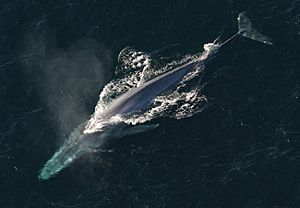 |
|
| An adult blue whale (Balaenoptera musculus) | |
 |
|
| Size compared to an average human | |
| Conservation status | |
| Scientific classification | |
| Genus: |
Balaenoptera
|
| Species: |
musculus
|
| Subspecies | |
|
|
 |
|
| Blue whale range (in blue) | |
| Synonyms | |
|
|
Contents
Blue Whale Features
The blue whale has a long, thin body with a wide, U-shaped head. Its flippers are long and slender. It has a small, sickle-shaped dorsal fin (back fin) about 33 centimeters (13 in) long, located near its tail. The tail itself is large, wide, and thin.
Inside its upper jaw, a blue whale has 70 to 395 black baleen plates. These plates are like giant combs that help them filter food. The whale's throat has 60 to 88 grooves, which allow its skin to stretch out a lot when it eats. Blue whales have two blowholes on top of their head, which can shoot water up to 9.1–12.2 meters (30–40 ft) into the air.
Their skin is a mottled grayish-blue color, which makes them look blue underwater. The patterns on their skin near the dorsal fin are unique to each whale, like fingerprints. Their belly is lighter and can look yellowish because of tiny plants called diatoms that live in the water. This is why they were sometimes called "sulphur bottom" whales.
How Big Are They?
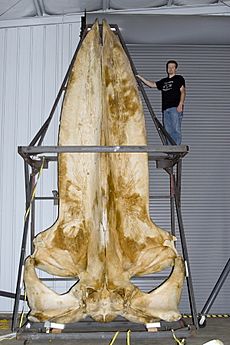
The blue whale is the biggest animal known to have ever lived. While some old records mention whales longer than 30 meters (98 ft), the longest blue whale scientifically measured was 30 meters (98 ft) from its nose to the tip of its tail. Female blue whales are usually larger than males. Scientists believe a blue whale probably can't grow longer than 33 meters (108 ft) because of how much energy their bodies need.
The average length for adult female blue whales varies by region. For example, females in the Eastern North Pacific are about 22.0 meters (72.1 ft) long, while those in the Antarctic are much larger, around 25.4–26.3 meters (83.4–86.3 ft). Pygmy blue whales are a bit smaller, averaging 21.3 meters (69.9 ft).
Blue whales are also incredibly heavy. In the Northern Hemisphere, males weigh about 100 metric tons (220,000 lb) and females about 112 metric tons (247,000 lb). Antarctic females can weigh up to 130 tonnes (290,000 lb). The heaviest blue whale ever recorded weighed 173 tonnes (190 short tons), with some estimates going up to 199 tonnes (220 short tons). A blue whale's heart alone can weigh 180 kg (400 lb), which is the biggest heart of any animal!
How Long Do They Live?
Blue whales typically live for about 80 to 90 years, or even longer. Scientists can tell a blue whale's age by looking at its earwax, also called an ear plug. Each year, a whale adds a light and a dark layer of wax. These layers show when the whale was feeding and when it was migrating and fasting. By counting these layers, scientists can estimate its age. The oldest blue whale found using this method was 110 years old!
Blue Whale Behavior
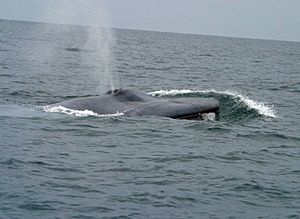
Blue whales are usually found alone, but sometimes they travel in pairs. If there's a lot of food in one area, you might see more than 50 blue whales together. Many blue whales go on long migrations. They travel to their summer feeding grounds near the poles and then head to warmer waters near the equator for winter to breed. It seems they remember where the best feeding spots are.
Some blue whales might stay in one place all year, or only certain age groups or sexes might migrate. Sometimes, whales are even seen feeding in their breeding areas. Blue whales usually travel at speeds between 5–30 kilometers per hour (3.1–18.6 mph).
Blue whales can dive very deep. The deepest dive recorded for a tagged blue whale was 315 meters (1,033 ft). The longest dive measured was 15.2 minutes. A pygmy blue whale was confirmed to dive as deep as 510 meters (1,660 ft). When a blue whale dives deep, its heart rate can slow down to just 2 beats per minute! But when it comes back to the surface, its heart rate can speed up to 37 beats per minute.
What Do Blue Whales Eat?
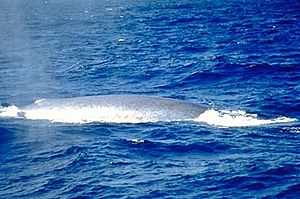
Blue whales eat almost nothing but krill. They catch krill by "lunge feeding." This means they swim very fast towards a group of krill with their mouths open wide, up to 80 degrees! They can take in about 220 metric tons (220 long tons; 240 short tons) of water at once. Then, they use their throat pouch and tongue to push the water out through their baleen plates, trapping the krill inside. After that, they swallow the krill. Blue whales have even been seen rolling 180 degrees while lunge feeding, probably to find the densest groups of krill.
To get enough energy, blue whales try to eat as much krill as possible. They need to swallow more than 100 krill per cubic meter of water to make lunge feeding worthwhile. One mouthful of krill can give them a huge amount of energy, up to 240 times more than they use for that single lunge! It's estimated that an average blue whale needs to eat about 1,120 ± 359 kilograms (2,469 ± 791 lb) of krill every day.
Blue whales seem to avoid competing directly with other baleen whales for food. Different whale species might eat different sizes of krill or feed in different areas or at different times. This helps them all find enough food.
Having Babies
Blue whales usually become ready to have babies when they are 8 to 10 years old. In the Northern Hemisphere, females are about 21–23 meters (69–75 ft) long when they mature, and males are 20–21 meters (66–69 ft). In the Southern Hemisphere, they are a bit longer.
Not much is known about how blue whales mate or exactly where they have their babies. It seems that male blue whales compete for females. A male whale might follow a female and try to scare away other males. They usually mate from fall to winter.
Pregnant female whales eat a lot, about four percent of their body weight each day during the summer. This helps them gain 60% of their body weight overall during this time. Pregnancy lasts about 10 to 12 months. When a calf is born, it's already huge, about 6–7 meters (20–23 ft) long and weighing 2–3 metric tons (2.0–3.0 long tons; 2.2–3.3 short tons)!
Baby blue whales drink a lot of milk. Estimates suggest that a mother blue whale produces about 220 kilograms (490 lb) of milk each day. The first video of a blue whale calf possibly nursing was filmed in New Zealand in 2016. Calves are usually weaned (stop drinking milk) when they are 6 to 8 months old and about 16 meters (53 ft) long. They gain a lot of weight during this time, roughly 37,500 pounds (17,000 kg). Mothers usually have a new calf every two to three years.
Blue Whale Sounds
Blue whales make some of the loudest and lowest-pitched sounds in the animal world. Their ears are very good at hearing these low-frequency sounds. The main pitch of their calls ranges from 8 to 25 Hz. Blue whale songs are different depending on where the whales live.
Scientists have studied the calls of blue whales in the Eastern North Pacific a lot. These whales make "A" calls (pulsed sounds) and "B" calls (tonal sounds), as well as "C" calls (upswept tones before B calls) and "D" calls (downswept tones). A and B calls are often sung together in a pattern, and only males make them, suggesting they are used for mating. D calls might have different uses. Both male and female whales make D calls when they are interacting while feeding, and males also make them when competing for mates.
Blue whale calls recorded near Sri Lanka have a three-part phrase. Calls from Madagascar have a two-part phrase. In the Southern Ocean, blue whales make 18-second calls that start with a 9-second, 27 Hz tone, then drop to 19 Hz, and then to 18 Hz.
Interestingly, some blue whale songs have become lower in pitch over time. For example, the calls of blue whales in the Eastern North Pacific dropped in pitch by 31% from the 1960s to the early 2000s. The calls of pygmy blue whales in the Antarctic have also been getting slightly lower each year since 2002. One idea is that as blue whale populations recover from whaling, larger whales might be more attractive mates, and lower-pitched calls could signal a larger body size.
Enemies and Hitchhikers
The only known natural enemy of blue whales is the orca. However, we don't know how often orcas successfully kill blue whales. Studies of blue whales in the Gulf of California show that many of them have rake-like scars, which means they've had encounters with orcas.
There have been a few documented cases of orcas chasing or attacking blue whales. The first recorded attack happened in 1977 off Mexico, but the injured blue whale escaped. In 2003, a group of orcas was seen feeding on a recently killed blue whale calf. More recently, in 2019 and 2021, direct observations of orcas successfully hunting blue whales were made off Western Australia.
Blue whales can also have other creatures living on or inside them. In Antarctic waters, tiny plants called diatoms can grow on their skin, making them look yellowish. These usually fall off when the whales swim into warmer waters. Other external creatures include barnacles, which attach to their skin and can leave a pit if removed. Whale lice are tiny creatures that live in skin cracks but usually don't harm the whale. Some tiny worms, called copepods, dig into the whale's blubber to feed.
Inside their bodies, blue whales can have different types of worms, including trematodes, tapeworms, and thorny-headed worms. In the North Atlantic, blue whales can also have tiny organisms called protozoans.
Protecting Blue Whales
The total number of blue whales in the world is estimated to be between 10,000 and 25,000 as of 2018. This is much less than the 140,000 or more whales that existed in 1926. There are about 1,000 to 3,000 whales in the North Atlantic, 3,000 to 5,000 in the North Pacific, and 5,000 to 8,000 in the Antarctic. Pygmy blue whales might number between 2,000 and 5,000.
Blue whales have been protected in some parts of the world since 1939. In 1955, they were fully protected in the North Atlantic, and this protection was extended worldwide by 1966. In the US, they are protected under the Endangered Species Act.
Blue whales are officially listed as endangered by the US Endangered Species Act and the IUCN Red List. They are also protected by international agreements like Convention on International Trade in Endangered Species of Wild Fauna and Flora and the Convention on the Conservation of Migratory Species of Wild Animals. Some groups of blue whales, like those in the Antarctic, are even considered critically endangered.
Dangers to Blue Whales
In the past, blue whales were hard to hunt because they were so big and fast. But in the mid-1800s, new harpoons were invented that could be shot, making it easier. Blue whale hunting was at its peak between 1930 and 1931, when 30,000 whales were killed. In the first half of the 20th century, about 350,000 to 360,000 blue whales were killed in the Antarctic alone. Many were also killed in the North Atlantic and North Pacific. The International Whaling Commission banned all blue whale hunting in 1966, giving them protection worldwide. However, the Soviet Union continued to illegally hunt blue whales until the 1970s.
Today, one of the biggest dangers to blue whales is being hit by ships. This is a major problem, especially off the US West Coast. Between 1998 and 2019, 17 blue whales were killed or thought to have been killed by ships in that area. In Sri Lankan waters, where busy shipping lanes cross whale habitats, ship strikes also cause many deaths. To help prevent this, scientists are looking into better ways to predict where whales are, changing shipping lanes, slowing down ships, and managing shipping routes seasonally.
Blue whales can also get caught in fishing gear, though this is less common. A few cases have been reported off California and in Sri Lanka, where a blue whale was found tangled in a net.
Another growing problem for blue whales is human-made underwater noise. They can be affected by noise from commercial ships and from seismic surveys used to find oil and gas. Studies have shown that blue whales in some areas reduce their calling when they hear mid-frequency sonar. This noise can also interrupt their deep-dive feeding, though it depends on how close the sound is and if there's food available.
The effects of pollutants on blue whales are not fully known. However, because blue whales eat low on the food chain (mostly krill), they are less likely to build up high levels of harmful chemicals in their bodies. Still, analysis of earwax from a blue whale killed by a ship showed contaminants like pesticides, flame retardants, and mercury. This also suggested that mothers can pass these chemicals to their babies during pregnancy or nursing. Male blue whales in the Gulf of Saint Lawrence in Canada were found to have higher levels of certain pollutants compared to females, likely because females pass these chemicals on to their young.
See also
 In Spanish: Ballena azul para niños
In Spanish: Ballena azul para niños



